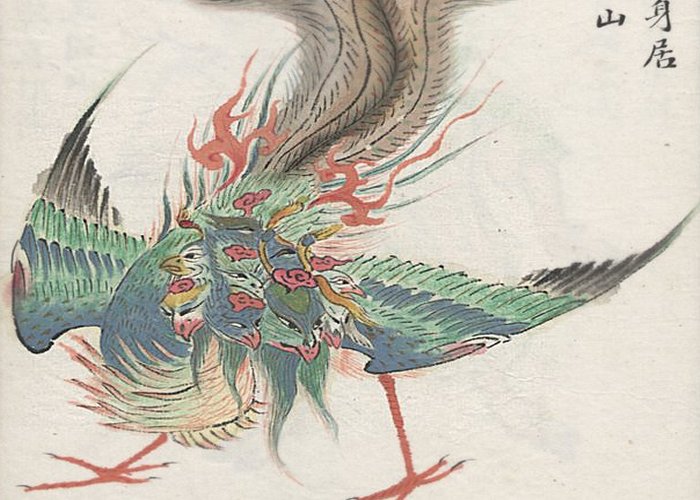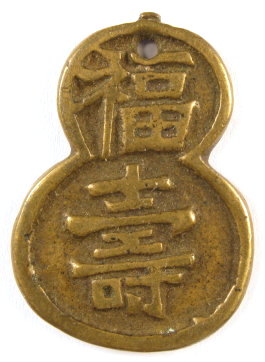
Last week I focused on a Chinese tale because of the Lunar New Year. This week I finished listening to The Girl with Ghost Eyes, which takes place in San Francisco’s Chinatown at the end of the nineteenth century and incorporates a lot of the Chinese culture, traditions and legends. I decided to stick with the Chinese theme today. “The Bird with Nine Heads” comes from The Chinese Fairy Book edited by Dr. R. Wilhelm, 1921.
There once lived a king and a queen who had a daughter. One day, when the daughter was walking in the garden, a huge storm suddenly came up and carried her away. The storm had come from the bird with nine heads, who had stolen the princess and brought her to his cave. The king did not know where his daughter had disappeared to, so he proclaimed throughout the land: “Whoever brings back the princess may have her for his bride!”
Now a young man had seen the bird as he was carrying the princess to his cave. The cave, though, was in the middle of a sheer wall of rock. You couldn’t climb up to it from below, or climb down to it from above. As the man was walking around the rock, another young man came along and asked him what he was doing there. So the first man told him that the bird with nine heads had carried off the king’s daughter, and had brought her up to his cave. The other knew what he had to do. He called together his friends, and they lowered the young man to the cave in a basket. When he went into the cave, he saw the princess sitting there washing the wound of the bird with nine heads; the hound of heaven had bitten off his tenth head and his wound was still bleeding. The princess, however, motioned to the youth to hide, and he did so. When the king’s daughter had washed the wound and bandaged it, the bird with nine heads felt so comfortable, that one after another, all his nine heads fell asleep. Then the youth stepped out from his hiding place and cut off the bird’s nine heads with a sword.
The princess told him that it would be best if he was hauled up first and she would follow, but the young man insisted that he would wait below until she was safe. Not the smartest move. He really should have listened to the princess, it would have been less of a hassle. Of course, he could also have been killed by the other guy and his friends, so it’s a toss-up.
Before the girl climbed into the basket, she took a long pin from her hair, broke it into two halves and gave him one and kept the other. She also divided her silken kerchief with him, and told him to take good care of both her gifts. Of course, when the other man had drawn up the king’s daughter, he took her along with him and left the young man in the cave, in spite of all his calling and pleading.
The man took a walk around the cave. He saw several corpses of maidens who had been carried off by the bird. He also saw a fish nailed to the wall. When he touched the fish, the latter turned into a handsome youth, who thanked him for delivering him, and they agreed to regard each other as brothers. Soon the first young man grew hungry. He stepped out in front of the cave to search for food, but only stones were lying there. Then, he saw a great dragon, who was licking a stone. The youth imitated him, and before long his hunger had disappeared. He next asked the dragon how he could get away from the cave, and the dragon nodded his head in the direction of his tail, to say he should seat on it. So he climbed on, and in the twinkling of an eye he was down on the ground, and the dragon had disappeared. The young man walked on until he found a tortoise-shell full of beautiful pearls, magic peals that could put out fire or divide water so you could walk through it. He took the pearls out of the tortoise-shell, and put them in his pocket. Soon he reached the shore and flung a pearl into the sea. At once the water divided and he could see the sea dragon. The sea dragon cried, “Who is disturbing me here in my own kingdom?” The young man replied, “I found pearls in a tortoise-shell, and have flung one into the sea, and now the waters have divided for me.”
The dragon invited the man to come into the sea and live with him. Then the man recognized him for the same dragon he had seen in the cave.With him was the youth he had saved, he was the dragon’s son. “Since you have saved my son and become his brother, I am your father,” said the old dragon. He entertained him hospitably with food and wine.
One day his friend said to him: “My father is sure to want to reward you. But accept no money, nor any jewels from him, but only the little gourd flask over yonder. With it you can conjure up whatever you wish.” Sure enough, the old dragon asked him what he wanted by way of a reward, and the man answered: “I want no money, nor any jewels. All I want is the little gourd flask over yonder.” At first the dragon didn’t want to give it up, but at last he let him have it. And then the man left the dragon’s castle.
When he set his foot on dry land again he felt hungry. At once a table stood before him, covered with a fine and plenteous meal. He ate and drank. After he had gone on a while, he felt weary, and there stood a donkey, waiting for him. After he had ridden the donkey for a while, along came a wagon, and then a litter, which took him to the princess’s city.
When the other man had brought back the king’s daughter, it was decided to hold the wedding. But the princess was unwilling, declaring that he was the wrong man and the one who really saved her would appear and would have with him half of the long pin for her hair, and half of her silken kerchief. but the man did not appear for a long time and the king grew impatient. Finally, he announced that the wedding would take place the next day. The princess wandered through the streets, hoping to find the young man who had saved her. Luckily, that was the same day he arrived. The king’s daughter saw the half of her silken handkerchief in the youth’s hand, and filled with joy, she led him to her father. There he had to show his half of the long pin, which fit the other exactly. The king was convinced that he was the right, true deliverer. The false bridegroom was punished, the wedding celebrated, and they lived in peace and happiness till the end of their days.
If this had been a Grimm tale, we might have heard what terrible punishment the liar had to endure, but we’re spared that here.
A note at the end of the story says gourd flasks often occur as magic talismans in Chinese fairy-tales, and spirits who serve their owners are often imprisoned in them.
In doing a bit of quick looking around the web, I found some more information on gourds in ancient China. In Daoism, which is the tradition of the main character in The Girl with Ghost Eyes, the gourd shape is taken to represent heaven and earth with an extended meaning representing the entire universe. Within the gourd there is a mystical zone in the form of an alternate universe or the entrance to another world, and Daoist immortals and practitioners can travel between these two worlds.
Because of this association, the bottle gourd has long been a Chinese symbol of self-containment and self-sufficiency. Old Chinese fables sometimes describe a person accidentally coming upon a small, narrow opening in the mountains and entering into a mystical or fairy world where people enjoy peace and long and happy lives. This same physical characteristic of the gourd carries over into the traditional Chinese garden where a person enters an enclosed but spacious compound through a small opening or gate. The gourd is also the Daoist symbol of alchemy. It was believed that the “elixir of immortality” could be produced through the distilling of red cinnabar placed in the upper chamber of the gourd and mercury placed in the lower chamber.
The Chinese word for gourd, hulu (葫芦), has auspicious associations. In some dialects, the character hu (葫) has a similar pronunciation to fu (福) which means “happiness” or “good fortune.” Therefore, saying hulu (葫 芦) for gourd would sound similar to fulu (福禄) which means “happiness and rank.” Also, in ancient times, old men would frequently be seen carrying gourds on their backs. Gourds, therefore, gradually became associated with old age and charms, such as the one pictured below, took on the gourd-shape to signify longevity. This is an example of an old gourd charm that has the Chinese characters fu (福) and shou (寿). Fu means “happiness” and shou means “longevity.” The reverse side has the Chinese characters shuang (双) and quan (全).Shuang means “both” and quan means “complete.” The entire inscription therefore reads “Happiness and Longevity both complete.” Makes me want a gourd charm to wear.
Thursday’s Tales is a weekly event here at Carol’s Notebook. Fairy tales, folktales, tall tales, even re-tellings, I love them all. Feel free to join in.


Interesting story 🙂